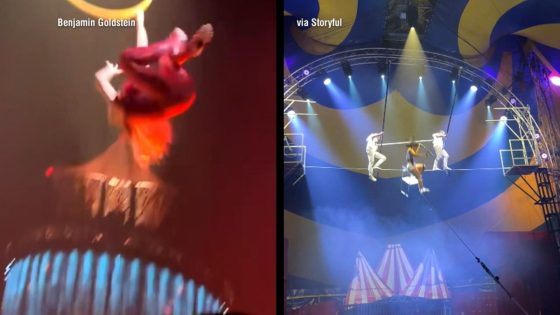Throngs of spectators from all corners of the world gather under the big top to marvel at awe-inspiring performances. However, behind these incredible stunts lies a world of extraordinary risks and challenges for the daring performers.
Last month, floating high above the crowd, a Cirque du Soleil aerial artist lost her grip on a hoop mid-stunt and plummeted to the ground during a show in Portland as bystanders watched in horror.
The artist is doing well and has been discharged from the hospital, Cirque du Soleil put out a statement.
“On Saturday, August 24, an aerial hoop artist was injured during a performance of KOOZA by Cirque du Soleil in Portland. The artist is doing well and has now been discharged from the hospital, whilst being cared for by our team. As always, the artist will continue to be monitored by the KOOZA medical and coaching team to determine when she can return to the show. In the meantime, the KOOZA performance schedule at Portland Expo Center remains unchanged. The show will be presented under the Big Top until October 6, 2024.”
And just days before that, another harrowing fall occurred during a tightrope chair stunt during England’s Gravity Circus, performed by “The High Wire Troupe.” The performer survived their fall, according to a statement by Gravity Circus.
“We can confirm that an accident occurred last night involving one of our tightrope performers during the show. In live entertainment and high-risk performances, accidents can unfortunately happen despite stringent safety measures. Our emergency protocols were immediately enacted, and the performer was promptly taken to the hospital. Our primary concern is the wellbeing of the performer, their family, the high wire troupe, and our entire circus family. We are closely monitoring the situation and conducting a thorough investigation.”
With stakes this high, many circus performers prepare for these big moments and learn how to protect themselves by going to circus school, where they are trained to handle such risks with utmost safety and preparation.
VIDEO: Circus accidents put spotlight on high-stakes profession
ABCNews.com
Nestled in Philadelphia, the Circadium School of Contemporary Circus stands as a unique institution, one of the few professional circus programs in the country, and the only one accredited to offer a diploma in circus arts.
“For students who want a higher education pathway, where they get a diploma after three years of full-time study from an accredited school, this is their place,” said Shana Kennedy, executive director at Circadium School.
Kennedy, a former juggler and an aerialist, originally began teaching in her backyard with her husband in 2014 before founding circadium as a licensed institution in 2017.
Circadium is at the forefront of training the next generation of performers to learn the type of acrobatic feats famously showcased in programs like Cirque du Soleil.
“So a hundred years ago if you wanted to be in the circus, you needed to be raised in the circus, be part of a circus family, or run away and join the circus, as people would say,” Kennedy said.
The circus has been in this country since the late 1700s. The first circus in the U.S. was in Philadelphia in 1793. The old circus featured elephants, lions jumping through hoops, bears on bicycles, and the big top was generally seen as a place for fun, spectacle, and clowns – lots of clowns.
However, now many circuses appear entirely different. Instead of elephants and fire breathers, spectators witness gasp-inducing acrobatic feats.
For would-be circus performers in the U.S., it’s a dream scenario to have an option after high school to attend a school that could help them live out their dreams. It’s a dream Ava Gowanloch, Hailey Van Nyhuis, and Bailey Luk all decided to pursue.
“My parents always knew that I wasn’t really gonna go to normal four-year college,” Van Nyhuis said. “But they, like, always tell me that their friends were like, ‘Oh, it’s so great you’re letting Hailey do what she wants.’ And they’re like, ‘We didn’t have a choice.'”
Like a typical college, each student chooses a major. For example, Luk majors in aerial straps, while Van Nyhuis is a trapeze artist.
“I had no idea I wanted to do circus,” Luk said. I took recreational classes and I went to normal college. I was studying to do science. And then one day, I just decided to, to do this instead.”
Gowanloch is a contortionist, an entertainer who twists and bends their body into strange and unusual positions.
The students, however, don’t just practice death-defying tricks all day; there’s also some classroom work at circus school.
“So we try to keep the kind of written and academic portions of the class all related to their art form, and to their careers,” Kennedy said. “So we do a career-planning class where we do financial management, and we do marketing.”
Tuition at Circadium is $12,980 per year, which Kennedy says makes it an affordable option for potential students.
According to Indeed.com, the national average salary for a circus performer in the U.S. is around $77,000 annually, with average salaries at the biggest shows, such as Cirque du Soleil, exceeding twice that amount.
The admission standards for entry into Circadium are set exceptionally high due to the high level of risk involved in circus performance.
In 2018, Yann Arnaud, a Cirque du Soleil aerialist, died after falling during a high-flying routine. Additionally, multiple performers were injured during a 2014 Ringling Brothers show in Rhode Island.
Those tragic accidents, along with the two from last month, highlight the risks involved in these types of performances.
“We prepare our students for when they go out into the world, being in a space that may not be as controlled as this,” Kennedy said. “So when they– when they work professionally, they’re going to be in tents, they’re gonna be in buildings, they’re gonna be working for corporate clients where they may have to rig their own apparatus.”
Source Agencies




